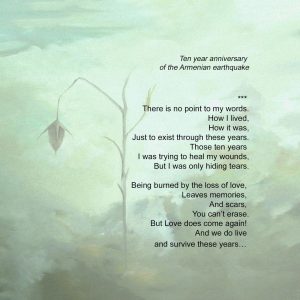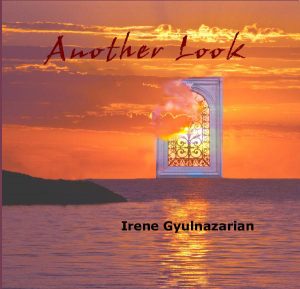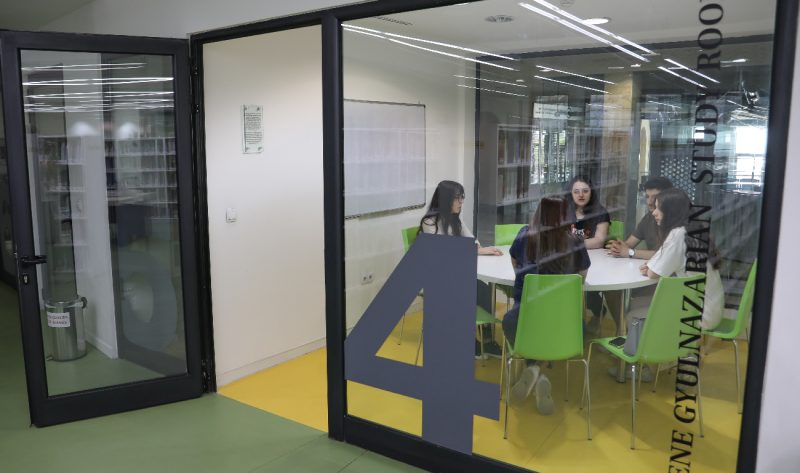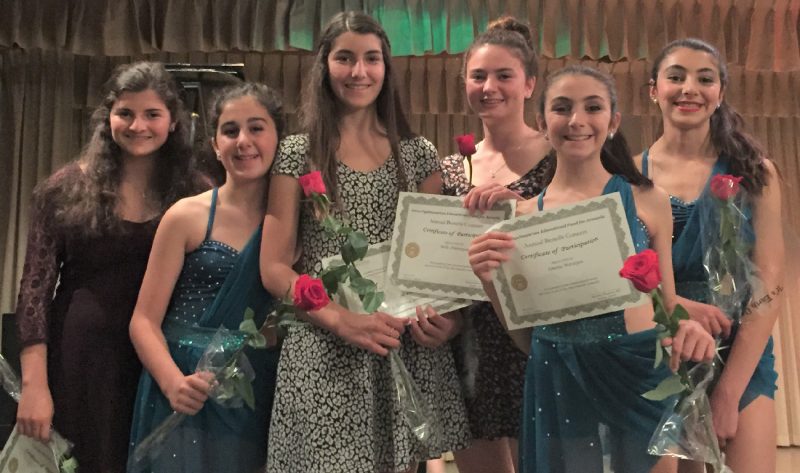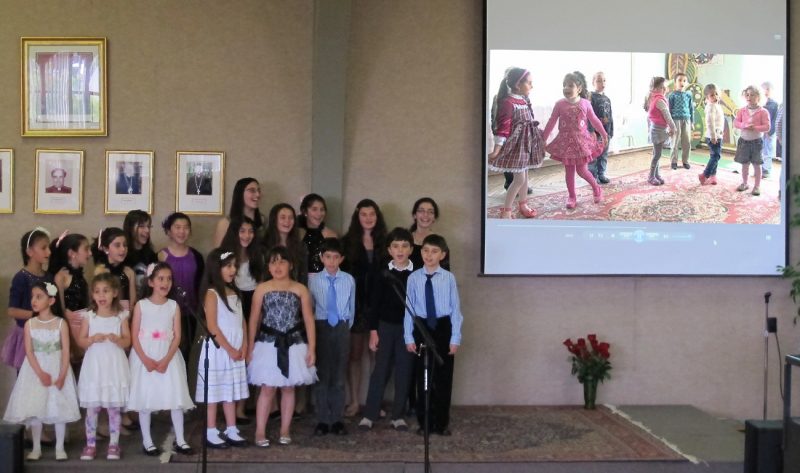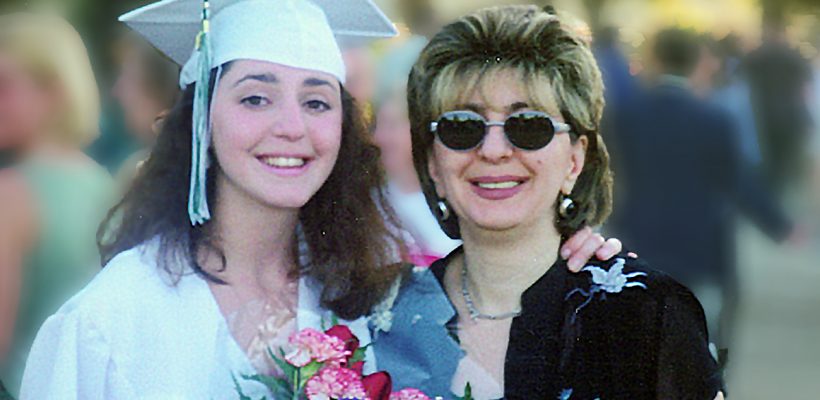
Swimming Through Rough Waters: The Legacy of Irene Gyulnazarian at AUA
7 min readIrene Gyulnazarian’s life can be described using the motions of the ocean: the splendor of the small waves of her beautiful childhood and playful youth; a tsunami marking the turning point of innocence with the impact of the Spitak earthquake; riding the waves into a new world, picking up the pieces and forming her new identity; and her final row through rough waters, sailing toward the eternal sky.
Irene was born on February 15, 1981, and left us on June 15, 2003. In her brief 22-years, she lived a life filled with rich and life-defining moments. She was born in Gyumri, but grew up in Yerevan, often going back to visit her grandparents and other relatives who still lived in her birth town. Her childhood, as she described it in her essays, was warm, filled with joy, and very family-oriented. Irene spent much of her time reading books, influenced by her educated parents who both held doctorate degrees before the age of 30. In some of her essays, Irene recalled visiting her mother, Ruzanna Ohanjanian, at the university she taught at. “I used to sit in the back row, listening with fascination to her lectures. This is where I get my passion for learning and reading. I would read anything I could get my hands on,” reading her mother’s books and dictating her thesis to her as she typed it up. Later on in life, this love for literature grew as Irene took up writing and poetry.
On December 7, 1988, the Spitak earthquake struck, devastating the country and her life. Only seven years old, Irene was suddenly faced with the harsh realities of death and destruction as she heartbreakingly lost her beloved grandparents and four-year-old cousin when their home flattened to the ground. She remembered, “It was my first growing experience. For the first time, I had to deal with death, and not only my grandparents and cousins, but my town. The town where I was born and played so peacefully every summer with my cousins, running around… so happy. My dreams and hopes were broken that day; I was left to be just like that building, with all the insides that fell into the ground, the inside dreams that were devoured by the earth. This earthquake, the earthquake of ‘88, was the turning point of my life. I changed after this; my mother changed after this, the country changed, everything had changed and would never be the same. Maybe all this wasn’t a dream; perhaps it’s a nightmare called life, the harsh reality of truth that we all lose sometimes.”
Her whole family was shaken. Her mother, a psychologist, coped with the loss by working with earthquake survivors suffering from PTSD. She would often take Irene along with her, visiting hospitals and shelters. Irene was inspired by watching her mother speak with a wide range of people, young and elderly. She later attributed her desire to study psychology to these experiences.
In 1992, when Irene was 11 years old, she and her mother moved to the San Francisco Bay Area. Enrolling in Palo Alto Middle School was a big transition for her, as she jumped a grade up and was faced with many other challenges, along with learning a new language. “It was only my second week in the U.S., and I was completely blasted with culture shock, but even more than that, it was difficult being away from my family, country, culture, and everything I loved and called home.” But soon enough, day by day, she immersed herself into forming a new identity as an Armenian-American, and by the end of her first year there, she had already become fluent in English.
Gradually, Irene found ways to adapt to her new life and new ways to express herself. Though at the time, there were no other Armenian peers at her school, she was able to seek familiarity and comfort by getting involved in different Armenian youth organizations in the area, seeking ties between her Armenian culture and the American culture. She continued her artistic pursuits, rediscovering her passion for playing the piano and also expanding upon her writing. “I loved to write, including poetry, pouring out all of my confusion and melancholy about being so far away from my home and family. I felt like I was establishing myself again, making myself a new home on the other side of the planet,” she recalled later. In many ways, writing became an outlet for her to heal from the trauma of what she had endured.
Not only was Irene gifted intellectually, having been recognized for her academic achievements on the National Dean’s List for the entirety of her college career, she also pushed herself to be the best version of herself, studying theatre, literature, poetry, music, and even trying her hand at skydiving. She manifested her spirit, that of an artist, through her work, and had her poetry published and recognized, going on to win multiple awards for her writing. Her poems were included in several poetry books and publications in the U.S., Europe, and Armenia. In 2002, Irene received an Editor’s Choice Award for outstanding achievements in poetry, and in 2003 and 2005, the International Society of Poets honored her with two Silver Cup Awards.
After successfully completing her junior year of college at the University of California, Santa Barbara, where she was studying psychology, Irene was returning home to enjoy her summer break. Unfortunately, on her way back, she was involved in a car accident that tragically cut her life short.
After Irene’s passing, her entire community and everyone who cherished and loved her dearly were in shock. This wave was felt across people of all ages whose lives Irene had impacted through her warm nature and passionate charm. It took a long time for her mother to be able to pick up the pieces from her heartbreak, but by the end of 2003, a group of Irene’s and Ruzanna’s friends came together to create the Irene Gyulnazarian Educational Fund for Armenia (IGEFA) as a living memorial to Irene. IGEFA is a 501(c)(3) nonprofit organization dedicated to supporting academic and cultural institutions to help improve the quality of education in Armenia, and throughout the years, has funded many efforts in Armenia, including aiding students with scholarship support, providing grants, sponsoring libraries and schools with equipment, and facilitating educational seminars and mental health trainings. IGEFA has also supported the American University of Armenia (AUA) for many years, providing seminars on continuing education programs and awarding tuition assistance and scholarships for AUA students. Recently, the foundation also named a collaborative study room in AUA’s AGBU Papazian Library.
Dr. Ruzanna Ohanjanian, having taught at Yerevan State University herself, was well in tune with higher education institutions in Armenia. She recognized the reputation of AUA as a well-respected institution that contributes significantly to the economic and social development of Armenia. “By naming this room after Irene, we are supporting students and faculty, and in doing so, we honor knowledge, education, and culture—all things that Irene would have wanted. I hope this will help to influence other students to get inspired with their cultural heritage,” she says, adding that “education is human capital and therefore, it’s the most vital component that we need to invest in Armenia today, because education not only enhances individuals’ lives but also impacts society as a whole. Those who are students today will one day govern our country, so giving them that power of knowledge and critical thinking will help shape a healthy mentality for the whole nation.” Irene valued education tremendously, as well as her culture and morals. Her wish was for everyone to have the opportunity to receive a well-rounded, high-quality education.
On the center of the table inside the Irene Gyulnazarian Study Room sits a book titled Another Look, filled with Irene’s poetry. The book was published posthumously by her mother Ruzanna, in an effort she describes as a very difficult, yet healing, process. She had some of Irene’s poems, but slowly, she began finding more and more as she started going through Irene’s various notebooks and schoolwork. The idea then came forth to compile them in a book, so she dove into the process which took several years as she designed every element herself and spent hours on every component to make sure it came out the way Irene would have wanted to see it.
Symbolically, the effort played out as a spiritual collaboration between mother and daughter. “Working on the book was an amazing journey. For those couple of years, I was in a very special place because I was fully immersed in the project. It was an amazing experience for me, and I am really thankful to Irene for giving meaning to my life and a way to continue living.”
Ruzanna wants Irene to be remembered as an exceptional and strong person who left behind a special legacy of love and boundless respect for her Armenian culture. Irene had a unique ability to connect easily with everyone, bringing together people of all different ages. To this day, she continues to do this through IGEFA as all types of people come together to volunteer on different projects and events helping Armenian students and children achieve their educational aspirations. Dr. Ohanjanian adds that none of this would have been possible without the incredible community around her that rallied together to do all this great work and uphold Irene’s values to carry on her legacy. She expresses major gratitude to all those who, throughout the years, have served on the organization’s board, as well as to all IGEFA donors, friends and supporters who have never failed to lend a helping hand.
When asked what Irene’s message to AUA students today would be, Ruzanna replies, “Never forget who you are, never give up, and always believe in your inner strength,” words that Irene strived to live by:
“There are many things that I have had to overcome and many things that have had a profound effect on me. But all of my experiences inspired me to become a stronger, more mature person and learn how to push through life’s challenging moments. They helped me appreciate the value of my family, culture, and morals. Most of all, my experiences made me appreciate myself for being a strong person and toughing it up during hard times. I love helping people, I know I have it in me, and I am motivated to learn more to do so professionally. I know that education will be the key to my success. I eventually want to go to graduate school and get my Ph.D. in psychology. I am interested in studying the psychology of diverse cultures; how people from different countries react, perceive, and deal with specific issues like emigration, illness, and loss when in a foreign environment. I also want to study the kind of therapeutic effects music can have on people. But regardless of what I study or what I do, I will always be ready to swim through rough waters.”
Time passes and life runs by, but the spirit of Irene continues to live on, not only in her poetry, but also through the deeds of the organization that carries her name. For more information on IGEFA, visit www.igefafund.org.
- The Irene Gyulnazarian Study Room in the AUA AGBU Papazian Library
- Performers at an IGEFA benefit concert
- SF Bay Area children singing along with children of Gyumri at an IGEFA event
Founded in 1991, the American University of Armenia (AUA) is a private, independent university located in Yerevan, Armenia, affiliated with the University of California, and accredited by the WASC Senior College and University Commission in the United States. AUA provides local and international students with Western-style education through top-quality undergraduate, graduate, and certificate programs, promotes research and innovation, encourages civic engagement and community service, and fosters democratic values.

